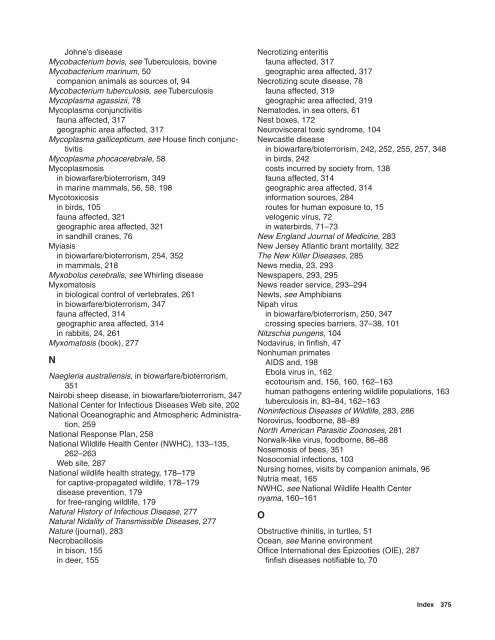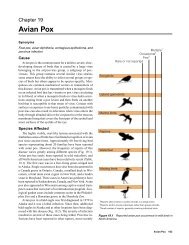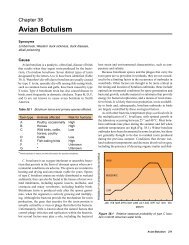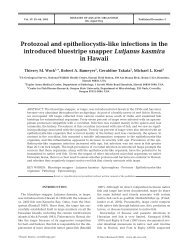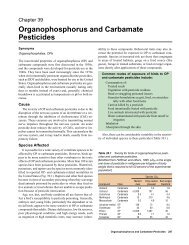Scientific names of animals and plants can be found in Appendix B. A
Scientific names of animals and plants can be found in Appendix B. A
Scientific names of animals and plants can be found in Appendix B. A
You also want an ePaper? Increase the reach of your titles
YUMPU automatically turns print PDFs into web optimized ePapers that Google loves.
Johne’s disease<br />
Mycobacterium bovis, see Tu<strong>be</strong>rculosis, bov<strong>in</strong>e<br />
Mycobacterium mar<strong>in</strong>um, 50<br />
companion <strong>animals</strong> as sources <strong>of</strong>, 94<br />
Mycobacterium tu<strong>be</strong>rculosis, see Tu<strong>be</strong>rculosis<br />
Mycoplasma agassizii, 78<br />
Mycoplasma conjunctivitis<br />
fauna affected, 317<br />
geographic area affected, 317<br />
Mycoplasma gallicepticum, see House f<strong>in</strong>ch conjunctivitis<br />
Mycoplasma phocacerebrale, 58<br />
Mycoplasmosis<br />
<strong>in</strong> biowarfare/bioterrorism, 349<br />
<strong>in</strong> mar<strong>in</strong>e mammals, 56, 58, 198<br />
Mycotoxicosis<br />
<strong>in</strong> birds, 105<br />
fauna affected, 321<br />
geographic area affected, 321<br />
<strong>in</strong> s<strong>and</strong>hill cranes, 76<br />
Myiasis<br />
<strong>in</strong> biowarfare/bioterrorism, 254, 352<br />
<strong>in</strong> mammals, 218<br />
Myxobolus cerebralis, see Whirl<strong>in</strong>g disease<br />
Myxomatosis<br />
<strong>in</strong> biological control <strong>of</strong> vertebrates, 261<br />
<strong>in</strong> biowarfare/bioterrorism, 347<br />
fauna affected, 314<br />
geographic area affected, 314<br />
<strong>in</strong> rabbits, 24, 261<br />
Myxomatosis (book), 277<br />
N<br />
Naegleria australiensis, <strong>in</strong> biowarfare/bioterrorism,<br />
351<br />
Nairobi sheep disease, <strong>in</strong> biowarfare/bioterrorism, 347<br />
National Center for Infectious Diseases Web site, 202<br />
National Oceanographic <strong>and</strong> Atmospheric Adm<strong>in</strong>istration,<br />
259<br />
National Response Plan, 258<br />
National Wildlife Health Center (NWHC), 133–135,<br />
262–263<br />
Web site, 287<br />
National wildlife health strategy, 178–179<br />
for captive-propagated wildlife, 178–179<br />
disease prevention, 179<br />
for free-rang<strong>in</strong>g wildlife, 179<br />
Natural History <strong>of</strong> Infectious Disease, 277<br />
Natural Nidality <strong>of</strong> Transmissible Diseases, 277<br />
Nature (journal), 283<br />
Necrobacillosis<br />
<strong>in</strong> bison, 155<br />
<strong>in</strong> deer, 155<br />
Necrotiz<strong>in</strong>g enteritis<br />
fauna affected, 317<br />
geographic area affected, 317<br />
Necrotiz<strong>in</strong>g scute disease, 78<br />
fauna affected, 319<br />
geographic area affected, 319<br />
Nematodes, <strong>in</strong> sea otters, 61<br />
Nest boxes, 172<br />
Neurovisceral toxic syndrome, 104<br />
Newcastle disease<br />
<strong>in</strong> biowarfare/bioterrorism, 242, 252, 255, 257, 348<br />
<strong>in</strong> birds, 242<br />
costs <strong>in</strong>curred by society from, 138<br />
fauna affected, 314<br />
geographic area affected, 314<br />
<strong>in</strong>formation sources, 284<br />
routes for human exposure to, 15<br />
velogenic virus, 72<br />
<strong>in</strong> waterbirds, 71–73<br />
New Engl<strong>and</strong> Journal <strong>of</strong> Medic<strong>in</strong>e, 283<br />
New Jersey Atlantic brant mortality, 322<br />
The New Killer Diseases, 285<br />
News media, 23, 293<br />
Newspapers, 293, 295<br />
News reader service, 293–294<br />
Newts, see Amphibians<br />
Nipah virus<br />
<strong>in</strong> biowarfare/bioterrorism, 250, 347<br />
cross<strong>in</strong>g species barriers, 37–38, 101<br />
Nitzschia pungens, 104<br />
Nodavirus, <strong>in</strong> f<strong>in</strong>fish, 47<br />
Nonhuman primates<br />
AIDS <strong>and</strong>, 198<br />
Ebola virus <strong>in</strong>, 162<br />
ecotourism <strong>and</strong>, 156, 160, 162–163<br />
human pathogens enter<strong>in</strong>g wildlife populations, 163<br />
tu<strong>be</strong>rculosis <strong>in</strong>, 83–84, 162–163<br />
Non<strong>in</strong>fectious Diseases <strong>of</strong> Wildlife, 283, 286<br />
Norovirus, foodborne, 88–89<br />
North Ameri<strong>can</strong> Parasitic Zoonoses, 281<br />
Norwalk-like virus, foodborne, 86–88<br />
Nosemosis <strong>of</strong> <strong>be</strong>es, 351<br />
Nosocomial <strong>in</strong>fections, 103<br />
Nurs<strong>in</strong>g homes, visits by companion <strong>animals</strong>, 96<br />
Nutria meat, 165<br />
NWHC, see National Wildlife Health Center<br />
nyama, 160–161<br />
O<br />
Obstructive rh<strong>in</strong>itis, <strong>in</strong> turtles, 51<br />
Ocean, see Mar<strong>in</strong>e environment<br />
Office International des Épizooties (OIE), 287<br />
f<strong>in</strong>fish diseases notifiable to, 70<br />
Index 375


